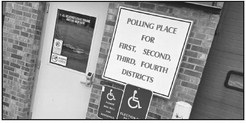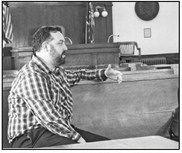Numbers, names and faces


“Do you ever stop and think ‘We are blessed.’” Those words were spoken to me nearly 30 years ago by Brian Holcomb, a high school classmate and friend. At the time, we were seniors at Edgewood Regional Senior High School and were in the golden glow of soon-to-be graduates with “futures so bright that we had to wear shades.” We were filled with optimism and a cocky assuredness as to our future potential.
Those words came back to me on Saturday afternoon when I received a message that Brian had died of complications from COVID-19. He was 46 years old. His daughter is nineyears- old.
Future reporter Fred, for the past few weeks I have sought to share some of the “slices of life” details to help you in the year 2120 with your 100th anniversary coverage of the COVID-19 pandemic. No doubt you have the facts and figures. Those dry spreadsheets and graphs reduce individuals to points of data and shrink entire lives to dots in a sea of information. You also have the added benefit of having read the last chapter and knowing how the story ends.
Each day we receive the tally of the sick and the dead. We cross our fingers hoping the number of new cases continue to spare our communities and our families. We see the politicians pointing fingers and attempting to use the pandemic as a stepping stone to power. We see sacrifi ce and courage among those who are working to care for the ill or who are helping slow the spread of the virus through individual choices.
This week’s issue of The Star News includes the first hand account of Medford native Wanda (nee Walczak) Bearth from her personal battle with COVID-19.
Her story helps bring home the reality of the illness and serves as a reminder of its severity.
Beyond the individual stories, there is also the very real public policy debate of how much do we shut down and for how long. This will largely be a numbers game where actuaries and policymakers balance potential lives lost against real economic loss to reach some acceptable level of risk.
When construction began on the Golden Gate Bridge in San Fransisco in 1933, the industry norm for construction projects was that one worker would die for every million dollars spent on the project. This was a vast improvement compared to the generation prior where 5% of all workers who worked on the Brooklyn Bridge died of workplace accidents and injuries.
The builders of the Golden Gate Bridge found the numbers to be unacceptable, and imposed additional safety measures which laid the groundwork for comprehensive workplace safety rules resulting in a dramatic decline in injuries and deaths.
Those new rules also brought expenses and changes in practices. While there will always be some who chafe at safety regulations, few would like to see a return to the bad old days.
I thought of this over the weekend when I saw a social media post from a would-be pundit wondering what the big deal was with COVID-19 since on average 98% of those who were diagnosed with it survive. This is the problem with percentages.
Two percent doesn’t seem like very much at all, but taken on any sort of scale and the significance becomes more pronounced. Using rough population averages 2% of the population equates to 100 people in a city the size of Medford, 400 people countywide, 120,000 statewide, and 6 million on a national level. These are the nightmare numbers that have prompted the abundance of caution leading to safer at home orders and in some places even curfews and restrictions on purchases to prevent hoarding of essential products.
Thinking back on my friend’s words so many years ago, I still feel we are blessed. With every blessing comes a burden to take that potential and make the most of opportunities and above all else to be thankful for every moment.
Brian Wilson is News Editor at The Star News.






